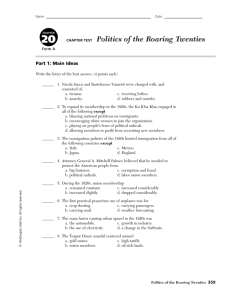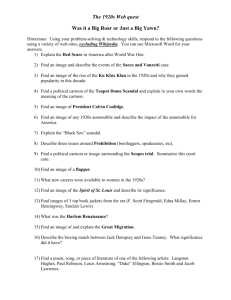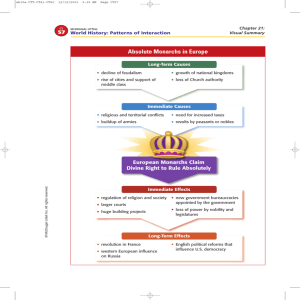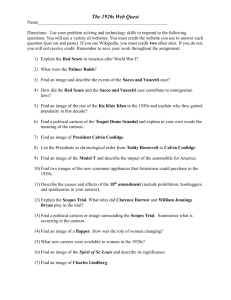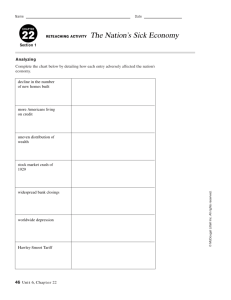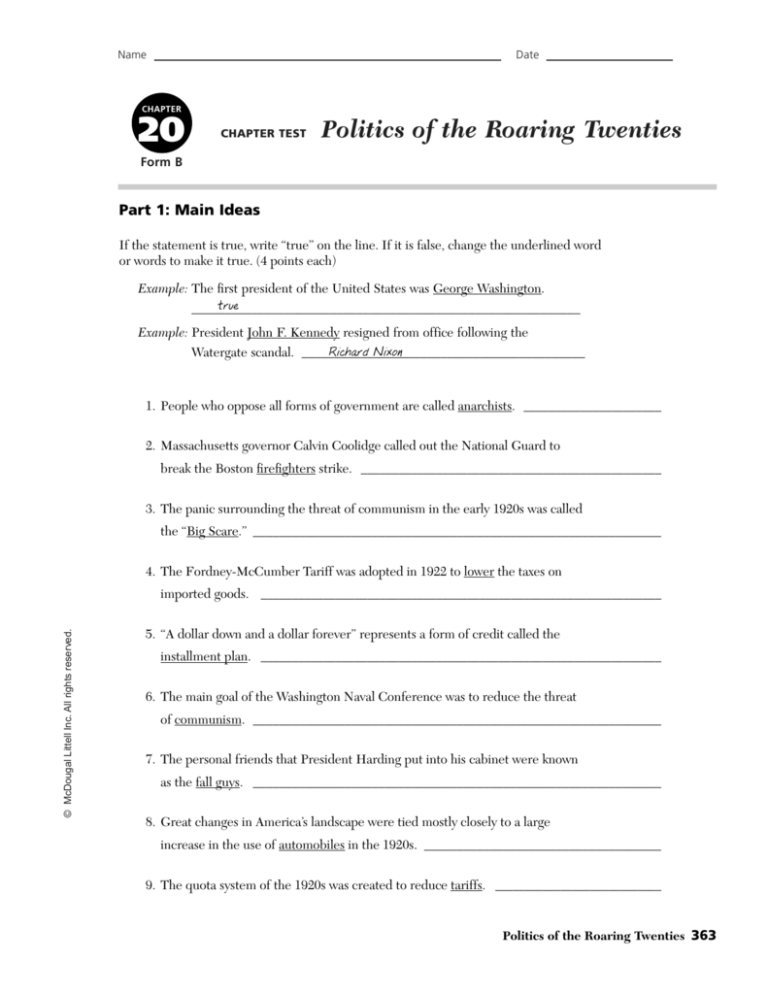
Name
Date
CHAPTER
20
CHAPTER TEST
Politics of the Roaring Twenties
Form B
Part 1: Main Ideas
If the statement is true, write “true” on the line. If it is false, change the underlined word
or words to make it true. (4 points each)
Example: The first president of the United States was George Washington.
true
___________________________________________________________
Example: President John F. Kennedy resigned from office following the
Richard Nixon
Watergate scandal. ___________________________________________
1. People who oppose all forms of government are called anarchists. ______________________
2. Massachusetts governor Calvin Coolidge called out the National Guard to
break the Boston firefighters strike. ________________________________________________
3. The panic surrounding the threat of communism in the early 1920s was called
the “Big Scare.” ______________________________________________________________
4. The Fordney-McCumber Tariff was adopted in 1922 to lower the taxes on
© McDougal Littell Inc. All rights reserved.
imported goods. ________________________________________________________________
5. “A dollar down and a dollar forever” represents a form of credit called the
installment plan. ________________________________________________________________
6. The main goal of the Washington Naval Conference was to reduce the threat
of communism. ______________________________________________________________
7. The personal friends that President Harding put into his cabinet were known
as the fall guys. ______________________________________________________________
8. Great changes in America’s landscape were tied mostly closely to a large
increase in the use of automobiles in the 1920s. ____________________________________
9. The quota system of the 1920s was created to reduce tariffs. ____________________________
Politics of the Roaring Twenties 363
Name
Test Form B continued
10. The Teapot Dome scandal involved the secret leasing of government-owned oil
reserves for profitable use by private companies. ____________________________________________
Part 2: Map Skills
Use the map to complete this section. Write the letter of the best answer. (2 points each)
Civil Air Routes, 1918 – 1930
Victoria
CANADA
Seattle
Portland
Great Falls
Montreal
Boise
Boston
Minneapolis
New York
Detroit
San Francisco
Chicago
Cheyenne
Salt Lake
City
Denver
Philadelphia
Pittsburgh
Washington
Omaha
Kansas City
St. Louis
Las Vegas
Nashville
Albuquerque
Los Angeles
Airport
Oklahoma
City
N
Tucson
El Paso
0
Air Routes
Fort Worth
Dallas
Jacksonville
New
Orleans
500 Miles
1000 Kilometers
1930: Flights begin to Mexico
and Central America
Brownsville
1930: Flights begin to Cuba
and South America
In 1918
By 1921
Pilottown
MEXICO
0
Atlanta
Miami
By 1930
______ 12. Which of the following statements is supported by the map?
a. The earliest purpose of civil air routes was connecting large northern cities
with large southern cities.
b. Flights crossing any body of water were not scheduled until well after 1930.
c. Air routes connecting the East Coast to the West Coast were in place before
routes that serviced the cities in the southern United States.
d. Civil air routes serviced all major U.S. cities before servicing any cities in
other countries.
______ 13. Which two cities did the first international air route connect?
a. New York and Montreal
c. Seattle and Victoria
b. New York and London
d. Miami and Paris
______ 14. What city was served by the greatest number of air routes by 1930?
a. Atlanta
c. Los Angeles
b. New York
d. Chicago
364 Unit 6, Chapter 20
© McDougal Littell Inc. All rights reserved.
______ 11. When was Washington, D.C., first served by a civil air route?
a. in 1918
c. by 1930
b. by 1921
d. after 1930
Name
Test Form B continued
______ 15. According to the map, which of these statements most accurately
describes civil air routes by 1930?
a. The purpose of civil air route development was to connect the United States
and Canada.
b. Civil air routes were added only to cities that had previously lacked service.
c. The rate of civil air route development consistently slowed after 1921.
d. Civil air routes serviced most major U.S. cities and were expanding to foreign countries.
Use the map on page 364 to answer the following questions in complete sentences on
the back of this paper or on a separate sheet. (5 points each)
16. In your opinion, why do the earliest air routes connect major cities?
17. Based on the map, what was the main goal of civil air route development
between 1918 and 1921?
Part 3: Interpreting Political Cartoons
© McDougal Littell Inc. All rights reserved.
Use the cartoon to answer questions 18–22 on page 366. Write the letter of the best answer. (2 points each)
—from the Literary Digest, March 20, 1920
Politics of the Roaring Twenties 365
Name
______ 18. The two men in this cartoon are
a. radicals.
b. union members.
Test Form B continued
c. nativists.
d. government officials.
______ 19. The title of the cartoon is “Shutting Out the Light.” The metaphorical “light” that the men are shutting out represents
a. the principles of labor unions.
c. radical foreign ideas.
b. Communist propaganda.
d. fundamental American ideals.
______ 20. According to the cartoon, radical ideas come from
a. the American people.
c. foreign and Communist countries.
b. the labor movement.
d. the U.S. government.
______ 21. According to the cartoon, a conflict exists between
a. the U.S. government and labor unions.
b. radical ideas and honest American ideas.
c. American radicals and foreign radicals.
d. the U.S. government and the American people.
______ 22. The line “Sunlight is unhealthy anyhow!” might be described as
a. more radical propaganda.
c. the voice of the American people.
b. an advertising slogan.
d. the voice of the U.S. government.
Use the cartoon on page 365 to answer the following questions in complete sentences on
the back of this paper or on a separate sheet. (5 points each)
23. What is the main idea of this cartoon?
24. Why is one of the men in this cartoon doing all the work?
Answer each of the following questions in a short essay on the back of this paper or on a
separate sheet. (10 points each)
25. What was the quota system of the 1920s? Explain why it was established, who
it affected, and several results of the policy. Think About:
• nativism
• immigration rates
• relations with foreign countries
26. Why were advertisements so successful in the 1920s? Do they serve the same
purpose today? Explain your answer. Think About:
• the needs and desires of the American public
• the goals of advertising
366 Unit 6, Chapter 20
© McDougal Littell Inc. All rights reserved.
Part 4: Extended Response

